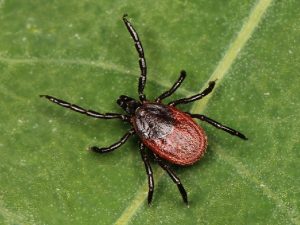Written by Linda Giampa —
CALIFORNIA — Whether heading out for a long backpacking trip, local day hikes, or an all-terrain run with our dogs, all of us are consistently aware of the need to pack provisions for varying weather, terrain and potential dangers. However, very few of us would stop to think about ticks or the dangers of tick-borne diseases that exist in California.
So what can be done to prevent ticks from spreading disease-causing bacteria to us?
Lyme disease, one of the most common infectious diseases in the country, is caused by the spread of the bacteria Borrelia burgdorferi to humans through the bite of infected ticks. There are about 329,000 new cases of Lyme disease each year, according to statistics released in 2013 by the CDC.
As a result of the difficulty in diagnosing and treating Lyme disease, as many as one million Americans may be suffering from the impact of its debilitating long term symptoms and complications, according to Bay Area Lyme Foundation estimates.
In the north-central regions of the United States, the western black-legged tick (Ixodes pacificus) is responsible for the spread of Borrelia burgdorferi, as well as other disease-causing bacteria, including the bacteria that causes human granulocytic anaplasmosis (HGA), a condition more commonly known as anaplasmosis, and Borrelia miyamotoi, which causes tick-borne relapsing fever in humans.
In fact, Borrelia miyamotoi rates in nymphal ticks in the Bay Area are higher than rates documented on the East Coast, although the actual number of ticks carrying miyomotoi remains greater on the East Coast. The same study showed that tick-borne disease risk is higher than previously believed in redwoods, which to-date have been widely thought to be a poor habitat for tick-borne disease.
If caught early, most cases of tick-borne disease can be treated, but they are commonly misdiagnosed due to lack of awareness and unreliable diagnostic tests. Current tests available in your doctor’s office are less than 50 percent accurate, meaning many people tested get false negative results, further exacerbating confusion and prolonging patient suffering.
Year-round tick risk
There is reason for year-round concern as ticks that carry Lyme disease in northwest California are active throughout the year according to data published by researchers from the California Department of Public Health and University of California-Berkeley in the peer-review journal, Ticks and Tick-borne Diseases.
These data underscore the need for residents to take precautions year-round and know the symptoms of the disease. While the threat in northern California is lower than on the East Coast, it’s believed to be more constant.
The findings suggest that the timing of peak tick activity of Western Black-legged ticks is largely predictable and year-round. In general, tick larvae (young ticks) are active April to June, and sometimes activity extends into October, while adult ticks are active from October to May. From January to October, nymphal ticks (which are younger and smaller than adult ticks but older than larvae) become active.
Interestingly, the highest reported incidence of Lyme disease in humans in northern California correlate to the times when the younger, smaller ticks (nymphal I. pacificus), which are smaller than a poppy seed, are most active. This is probably due to the fact that nymphal ticks are so tiny that they are very hard to detect.
Squirrels, rats and birds, oh my!
Compounding the growing problem of Lyme disease in northern California, host animals that most commonly carry Lyme disease are also active throughout the year and often live for extended periods of time, compared to host animals in the northeast United States. In the Northeast, few white footed mice, the host animals that most commonly carry the bacteria that causes Lyme disease in that region of the country, live through the cold winters. By contrast, the host animals that most commonly carry the bacteria that causes Lyme disease in California, western gray squirrel and dusky-footed wood rat, often live longer than one year thereby compounding the number of ticks that they infect over time.
Birds, too, can act as hosts for Lyme disease-causing bacteria in California, A recent study led by UC Berkeley researchers shows that birds are more important to the spread of the bacteria that causes Lyme and possibly other tick-borne diseases than previously recognized – and they are capable of carrying these diseases long distances.
The findings, published on Feb. 25, 2016 in the journal PLOS ONE, show that the birds, including American robins, dark-eyed juncos and golden-crowned sparrows, are important hosts of Lyme disease bacteria.
Widespread Risk
Tick-borne disease risk is higher than previously believed in redwoods, which to-date have been widely thought to be a poor habitat for tick-borne disease. Ticks are found in redwood habitats at lower densities than oak woodland, but they are consistently present and harbor both the newly-recognized tick-borne pathogen, Borrelia miyamotoi, which causes tick-borne relapsing fever, and Borrelia burgdorferi.
The study, which was conducted by researchers from Stanford University and Northern Arizona University and published in the peer-review resource PLOS ONE, found varying risk within Bay Area parks is based on several factors including geographic area and type of terrain (coast live oak, redwood, grassland etc.). The findings aligned with another study, published in Emerging Infectious Diseases, a publication of the Centers for Disease Control and Prevention (CDC), which found ticks carrying the bacteria that causes Lyme disease in recreational parks throughout the Bay Area, including wooded areas, grasslands and chaparral.
Larger Diversity of Bacteria
A vast diversity of bacterial species and strains that cause tick-borne diseases have been found in the Bay Area, according to the study noted above highlighting redwood risk.
The variety of bacterial species and strains may be the reason that Bay Area patients with tick-borne diseases experience a wide range of symptoms, which may or may not include flu-like complaints, joint pain, fatigue and a rash of differing shapes, thereby making exact diagnoses extremely difficult. The range of symptoms patients experience compounds the difficulty in diagnosing these patients and is extremely frustrating for both patients and medical professionals.
Prevention
To protect yourself and your family from Lyme disease, the Bay Area Lyme Foundation suggests the following to keep ticks – and tick-borne diseases – away:
- Wear light-colored clothes that make it easier to see ticks.
- Consider Deet for skin and permethrin for your clothes. A single application of permethrin to your clothing can provide up to six weeks of protection, even after repeated washings.
- Check common places to which ticks might latch-on – under the arms, in and around the ears, inside the belly button, behind the knees, between the legs, around the waist and especially in the hair.
- Redo tick checks 3 days after being in the woods.
- Put clothes in a hot dryer for one hour (before washing) after being in the woods or grasslands where you may have come in contact with ticks.
- Know the symptoms. Symptoms of the first stage of Lyme disease include headaches, flu-like symptoms, joint pain, fatigue and sometimes a rash. The current “gold standard” diagnostic for Lyme disease is a two-tiered blood test requiring a first-step ELISA (measurement of the total number of infection-fighting or memory antibodies against Borrelia burgdorferi), and it misses up to 60 percent of cases of early-stage Lyme disease.
- Don’t rely on a rash. Only approximately 70 percent of patients with Lyme disease have the rash as the initial symptom, and not all get the bull’s-eye shape. For a look at some of the other common shapes, go to: http://www.bayarealyme.org/get-help/lymes-many-symptoms
- Learn the correct way to remove a tick. You should position needle-nose tweezers between your skin and the tick’s mouth to gently tug the tick straight up from your skin. It may take two or three tries. Be sure to wash your hands and the area around the bite after removing the tick. Removing the tick incorrectly could allow the tick’s mouth – and bacteria – to remain.
More prevention tips and a list of symptoms can be found at: www.bayarealyme.org.





